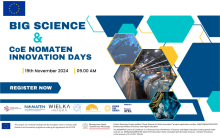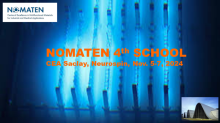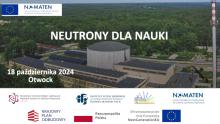NOMATEN - blog
We will show the interest of phase field methods to describe the evolution of microstructure in materials by discussing the nucleation and growth process in FeCr alloys during isochronous annealing. We have implemented...
Only recently, the development of fast differential scanning calorimetry (or chip-calorimetry) has allowed us to characterize in situ the glass transition response of metallic glasses during cooling from the liquid over a wider range of time scales employing scanning rates from 100 K/s up to 50,000 K/s. The generally accepted description is that the vitrification kinetics should exhibit the same temperature dependence as the relaxation time for the alpha-process. However, we have recently observed that vitrification at deep undercooling may occur
Laser powder bed fusion (LPBF) enables the fabrication of large-dimensioned bulk metallic glass (BMG) components; however, we are only just learning how to control the LPBF process to obtain specific mechanical properties. LPBF was used to produce dense and fully amorphous Zr59.3Cu28.8Nb1.5Al10.4 BMG samples from two different starting powders. One powder had a relatively finer particle size range of 10-45 μm and the other had a relatively coarser particle size range of 25-63 μm. Fully amorphous samples were achieved for both powders within a large processing window of
The safety and security of nuclear and radiological materials and their associated facilities share a common objective which is to ensure the protection of the population and the environment from an undue radiological hazard. Historically, many analytical methods...
Uranium-10wt.% molybdenum (U-10Mo) fuels are currently under consideration for the conversion of high-enriched U to low-enriched U fuels within high-performance research and test reactors to minimize proliferation concerns. These fuels are also of interest for small modular reactors and fast reactors, which require differing fabrication techniques. In general...
We are honoured to invite you to the Big Science and Nomaten Innovation Days, which will be held on November 19, 2024, at the National Center for Nuclear Research in Otwock (NCBJ) and is organized by the Science and Technology Park Świerk and NOMATEN Centre of Excellence.
High entropy alloys are a relatively new group of alloys in material science. Recent years of research have shown that these alloys have the potential to be the answer to the increasing property requirements of industrial development. One of the sectors where high-entropy alloys can find their application is in the energy, military and space industries. One of the fundamental expectations for constructional materials used in these sectors is...
The CEA is pleased to welcome you to the 4th international NOMATEN School (November 5-7th, 2024), held on the CEA Paris-Saclay campus, at NeuroSpin, a world-recognized unique research infrastructure dedicated to brain imaging. CEA is proud to have you again this year in France, a few weeks just after the Paris Olympics and Paralympics summer games, and 3 years after the very first NOMATEN school that was already organized by the CEA in Paris in November 2021. Like the previous similar and annually-organized NOMATEN schools...
Issues related to the design and manufacturing of new materials are a driving force behind the development of the modern world. Using the available materials in their natural form would significantly limit the possibility of their use in modern practical solutions. Therefore, progress has been observed for years in the area of miniaturization, strictly connected to the manufacturing technologies and use of new material solutions. A number of technologies are...
On October 18, 2024, the National Center for Nuclear Research in Świerk will host workshops on neutron technology and research carried out by Polish research groups.

Copyright NOMATEN 2017-2024









